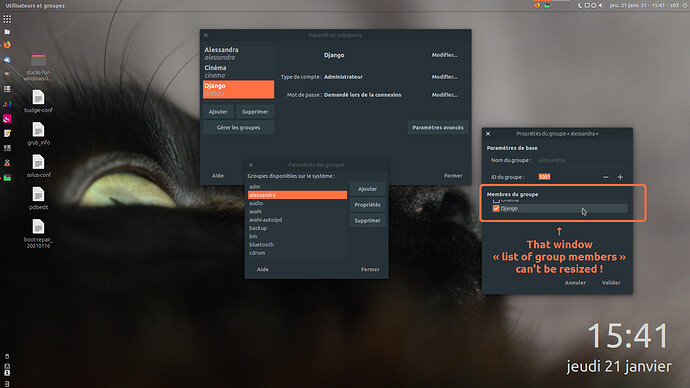Hello,
I found out that nowadays many DE lack an application to manage groups. Usually it is user settings, but there is no way to add or remove groups, join a group and so on. I found out that Ubuntu MATE actually has it. See attached screenshot.
I know it might sound not that big of a deal to do it from terminal, and that’s how I have been doing it for a long time. But I believe it would be quite handy for new Linux users or people that just want to get into Linux but not touch the terminal.
I would dare to suggest most new users will never need to touch groups - so managing user accounts is probably as far as they would go. Menu - Users
But the previous GUI is available for the more technically minded linux users
Hi, thanks for quick reply.
Often times software install requires users to join specific groups to work or avoid keep entering sudo password. Such as virt-manager, openrazer drivers, roccat drivers, I believe also virtualbox, and so on.
It is true that all of those have very clear instructions on how.to add user to groups from the command line.
Anyway, thanks for your time. Good talk
Those pieces of software are indeed in the “medium to advanced linux users” category!
1 Like
« User and groups » is available in *buntu repositories as part of gnome-system-tools.
But as many old administrative tools it has some UI problems :
gdebi has same UI problems with same kind of window for « list of dependencies ».
There also used to be a neat easy useful little utility for settings samba shares and users, system-config-samba no longer available as of 20.04 https://bugs.launchpad.net/ubuntu/+source/system-config-samba/+bug/1876999 or Bug #1740419 “Please remove system-config-samba from Ubuntu” : Bugs : system-config-samba package : Ubuntu
Ok these are for “medium to advanced linux users” but why let those users without well thought little graphical utilities ?
In same kind of ideas it seems nowadays weird not to have some graphical tools for setting
- ssh ( at least ) on a local network
- nfs shares since it’s not so rare « average » Linux users may have two Linux computers at home ( a desktop and a laptop ).
Setting samba shares, nfs shares or ssh/sftp through CLI are not so friendly while not being « rare » needs at home, while being almost « mandatory » in business / org.
ah well - like all software there does need people to look after it. All software are like plants - you need to regularly feed and water or the inevitable happens.
As always - opportunities abound for people to get involved.
1 Like
To be fair, setting up all those things can be done in a few ways: with webmin, or using openSUSE Leap which has yast available via ncurses or gui.
I was just thinking it is strange that the user gui had the groups management removed, when it was already there a few years ago. interesting choice 
Mmmm… I will sound bitter here, but I think there’s a gap regarding opportunities.
Once you are an user ( and not a dev’ ) with some « advanced » needs you are more and more often left with CLI and –help, man not to say RTFM.
Looks like people prefer to help with ( and fight about ) design rather than features and ease of life in real situation. If sharing data through samba, nfs, ssh no DE helps better than another, I think there’s some space for a DE or a distro to shine in that specific area.
I would not say « interesting » 
Some of these tools used to exist and work and help but as most « normal users » would not use them then nobody kept maintaining those. Sort of snake biting its own tail.
After all IT people and dev’ know how to set these kinds of things, so why bother with a GUI for the very few people that are not expert but may have expert needs ?
As if sharing data locally between 2 computers was an expert need… Or having many users on your system ( dad, mom, me, sister, brother… )
Maybe I’m old school dinosaur and everybody give their data to google-drive, dropbox, onedrive and the likes. At least Syncthing helps me with most of my needs but sometimes it’s like using a huge hammer to hit a tiny nail.
If you find those tools valuable, I recommend you try webmin. It is not perfect but it is really good. Works on most distributions, it is quite light and you can just open a webpage to your own host and access a lot of server and system admin tools in a nice interface. Also, if you find missing features or bug, you can report to their bug tracker and the team usually fixes those very quickly. It could be a nice way for a non-developer to contribute back to a project.



